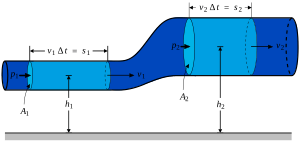Newtonian fluid facts for kids
| Mechanics | ||||||||||

|
||||||||||
A Newtonian fluid is a special type of fluid (like a liquid or a gas) that behaves in a very predictable way when you push or stir it. Imagine stirring a cup of water. The harder you stir, the faster the water moves. This simple relationship is what makes it a Newtonian fluid. The idea comes from the famous scientist Isaac Newton.
Contents
What is a Fluid?
A fluid is any substance that can flow and change its shape easily. This includes both liquids, like water or oil, and gases, like air. Unlike solids, fluids don't have a fixed shape; they take the shape of their container.
Understanding Viscosity
What Does Viscosity Mean?
Viscosity is a measure of how "thick" or "sticky" a fluid is, or how much it resists flowing. Think about it this way:
- Water has low viscosity; it flows very easily.
- Honey or syrup has high viscosity; it flows much more slowly.
- Tar has extremely high viscosity; it barely flows at all at room temperature.
How Viscosity Works in Newtonian Fluids
For a Newtonian fluid, its viscosity stays constant no matter how fast you stir it or how much force you apply. If you stir water gently or vigorously, its "thickness" doesn't change. The resistance it gives you is directly related to how fast you are trying to make it move.
Shear Stress and Flow
What is Shear Stress?
Imagine you have a layer of fluid, and you push the top layer sideways while the bottom layer stays still. The force you apply is called shear stress. It's like spreading butter on toast – you're applying a force that makes one part of the fluid slide past another.
How Newtonian Fluids React to Shear Stress
In a Newtonian fluid, the relationship between the shear stress you apply and how fast the fluid starts to flow (called the shear rate) is simple and linear. This means:
- If you double the force (shear stress), the fluid will flow twice as fast (double the shear rate).
- This direct relationship is why the viscosity of a Newtonian fluid remains constant.
Examples of Newtonian Fluids
Many common fluids around us are Newtonian. Some good examples include:
- Water: The most common example. Its viscosity doesn't change when you stir it faster.
- Air: The air we breathe is also a Newtonian fluid.
- Gasoline and Diesel: These fuels behave predictably when pumped.
- Light Oils: Such as motor oil at a constant temperature.
- Alcohol: Like ethanol.
Newtonian vs. Non-Newtonian Fluids
Not all fluids are Newtonian. Some fluids behave differently when you apply force to them. These are called Non-Newtonian fluids.
- For a Non-Newtonian fluid, the viscosity can change depending on the shear stress or shear rate.
- For example, ketchup can seem thick in the bottle but flows easily when shaken or squeezed hard.
- Another example is oobleck (a mixture of cornstarch and water), which acts like a liquid when gently poured but becomes solid when you punch it.
- A Boger fluid is a special type of non-Newtonian fluid that has a constant viscosity but also shows elastic properties.
Understanding Newtonian fluids helps scientists and engineers design everything from pipelines to car engines, as their behavior is easy to predict and work with.
See also
 In Spanish: Fluido newtoniano para niños
In Spanish: Fluido newtoniano para niños

